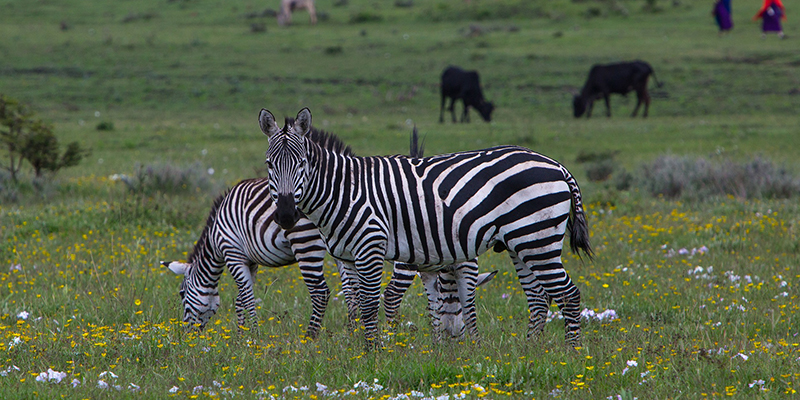Day 1: Arrival Nairobi
Depart from the airport on arrival and transfer you to Nairobi safari club hotel for overnight stay.
|
|
|
Day 2: Nairobi – Amboseli National park
Leave Nairobi at 0800 hrs and proceed to Amboseli national park to arrive in good time for lunch .Lunch at Amboseli Serena lodge followed by afternoon game drives at the magnificent park at the foothills of Mt.Kilimanjaro. Dinner and overnight at Amboseli Serena lodge
|
|
|
Day 3: Amboseli national park
Spend full day in this photogenic park. Morning and afternoon game drives. Meals and overnight at Amboseli Serena lodge Amboseli National park is one of the most popular wildlife sanctuaries in Kenya. It is situated close to Kenya. It is situated close to Kenya- Tanzania border, The Park lies at the foot of Mt. Kilimanjaro, the highest mountain in Africa (5,896m) whose snow-capped summit presents a splendid view on clear days. Amboseli National Park is often referred to as “The home of Elephants’ some of the largest Elephant herds are found here. The Game Park also contains vast groups of Zebras, Wildebeests, Giraffes, Buffalos, Hippos and Antelopes. Also to be found in Amboseli are lions, leopards, Cheetahs, Rhinos and many species of plain game
|
|
|
Day 4: Amboseli – Lake Manyara
Take breakfast then drive into Tanzania via the Namanga border. We also pass through Arusha for lunch and proceed to Lake Manyara National park with Regardless of the direction we approach Manyara from, the view is always fantastic. Dinner and overnight at Lake Manyara Serena lodge or similar. Lake Manyara is a shallow, alkaline lake that is part of the Rift Valley wall; the lake is at the base of this dramatic western escarpment giving it a beautiful and serene setting. In addition to this peaceful setting, Lake Manyara’s main attractions are its rich bird life, tree climbing lions and its hippos, which you can see at a closer range than many other places. Lake Manyara also hosts thousands of flamingos at certain times of the year and has diverse vegetation ranging from savannah, to marshes and acacia woodland, enabling a variety of wildlife habitats including butterflies.
|
|
|
Day 5: Lake Manyara – Serengeti National park
The day starts with morning game drives at Lake Manyara national park before proceeding to Serengeti national park with packed lunches. Game is viewed as we proceed to Serengeti Sopa lodge for overnight stay.
|
|
|
Day 6: Serengeti National Park
Spend the days exploring the vast park rich with abundant wildlife. You also visit the northern part of the park – Seronera with an opportunity of seeing the annual wildebeest migration. Dinner and overnight stay at Serengeti Sopa Lodge Serengeti is Africa’s most famous and Tanzania’s largest park covering 14,736 sq km and is adjoining with the Masai Mara National reserve in Kenya. With a wildebeest population of about 2 million and several other hoofed species (which include zebra, Thomson’s gazelle, impala, topi, Grants gazelle, Kongoni, Eland, Kirk’s dik dik, klipspringer, roan, Oryx, oribi, waterbuck, buffalo, giraffe and warthog), the Serengeti is sure to attract a string of prey such as lion, leopard, cheetah, hyena, golden jackals and bat eared foxes. Elephants are relatively scarce and the few remaining black rhinoceros are restricted to the Moru Koppies area. Serengeti also offers rewarding bird viewing with ostrich and kori bustard being common, a variety of larks, finches, and raptors can be seen but the most distinctive small bird is the lilac breasted roller.
|
|
|
Day 7: Serengeti – Ngorongoro Crater
Take early breakfast,then drive south to the magnificent Ngorongoro crater via the historical Olduvai Gorge whilst game watching only interrupted by a Packed lunches. Dinner and overnight stay at Ngorongoro Sopa lodge. The Olduvai Gorge cuts through rock beds layered in time sequence from 2 million years ago to the present. It is here where humanoid bones have been found dating back to over 1.75 million years including a direct ancestor of modern man. Fossil footprints (over three million years old) have also been found here and are the most ancient footprints yet discovered. There is an excellent site museum where you can explore the diggings with a guide and it is also a great place to view birds.
|
|
|
Day 8: Ngorongoro Crater
Take breakfast at leisure then descend into the crater for a full day crater tour with packed lunches . Ascend the crater rim for dinner and overnight stay at Sopa or serena lodge. The Ngorongoro Crater is often called ‘Africa’s Eden’ and the ‘8th Natural Wonder of the World,’ a visit to the crater is a main drawcard for tourists coming to Tanzania and a definite world-class attraction. The Ngorongoro Conservation Area (NCA) is home of Ngorongoro Crater. It was formed some 2.5 million years ago from a volcanic mountain sinking due to inactivity, and was initially thought to be higher than Tanzania’s famous Kilimanjaro.
The crater has evolved into a unique and integral part of Tanzania’s eco-system. The crater is actually a caldera, measures 22.5 km’s across and the rim walls stand 600m high. Views from within and from the rim are breathtaking (as can be seen from the picture). The crater houses 30,000 animals and a large variety of birds, which rarely move from the area due to the availability of water through wet and dry seasons
|
|
|
Day 9: Ngorongoro – Arusha – Nairobi
Take an early breakfast then drive to Arusha town for lunch then board an afternoon shutle bus to Nairobi departing at 1400 hrs – drop off at the airport to board your home bound flight.
|
|
|


